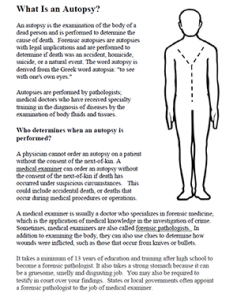
Students read a short article about autopsies and the scientists who perform them, such as forensic pathologists and medical examiners. The text includes references to careers in the field of forensics and what kind of training is necessary for that type of job.
An autopsy, also known as a post-mortem examination or necropsy (in the case of animals), is a thorough medical examination of a deceased person’s body to determine the cause of death and to understand the extent of disease or injury that may be present. Autopsies are typically performed by pathologists, medical doctors who specialize in diagnosing diseases by examining tissues and bodily fluids
The article also includes a detailed description of the procedures involved in an autopsy, such as the removal of organs. Students then answer questions based on a close reading of the test. They must analyze the main ideas of the article and to make comparisons between careers described.
You can also use a digital quiz I created for the article at Quizziz.
Time Required: 15-25 minutes
Grade Level: 11-12
CCSS.ELA-LITERACY.RST.11-12.2
Determine the central ideas or conclusions of a text; summarize complex concepts, processes, or information presented in a text by paraphrasing them in simpler but still accurate terms.
Other Resources on Forensics
Students also read selected chapters from “Stiff: The Curious Lives of Human Cadavers” as part of their course work.
If you are looking for more activities on forensics, check out “Estimating Time of Death,” where students use body temperature and other clues to determine ToD.
I also keep several college level textbooks with cadaver images, like the “Color Atlas of Anatomy.” Students are fascinated and mortified by photos of autopsies!
Featured Image: Autopsy by Nick Youngson CC BY-SA 3.0 Alpha Stock Images

